A curved surface is shown figure . The portion BCD is free of friction .There are three spherical balls of identical radii and masses . Balls are released from at rest one by one from A which is at a slighly greater height than C .

with the surface Ab , ball 1 has large eneough friction to cause rolling down without slipping , ball 2 has a small friction and ball 3 has a negligible friction .
(a) For which balls is total mechanical energy conserved ?
(b) Which ball (s) can reach D ?
(c ) For ball which do not reach D, which of the balls can reach back A ? Solution in Gujrati
(a) As ball 1 is rolling down withut slipping no disipation of energy is there , total mechanical energy remains unchanged . Hence , it is conserved .
(b) Ball 1 gains rtational energy , ball 2 loses energy due to friction . They cannot cross at C . Ball
Topper's Solved these Questions
- BOOK - KUMAR PRAKASHANCHAPTER - WORK, ENERGY AND POWER EXERCISE - SECTION - E Multiple Choice Questions (MCQs)64videos
WORK, ENERGY AND POWER
- BOOK - KUMAR PRAKASHANCHAPTER - WORK, ENERGY AND POWER EXERCISE - SECTION - F Questions From Module (Sample questions for preparation of competitive exams)23videos
WORK, ENERGY AND POWER
- BOOK - KUMAR PRAKASHANCHAPTER - WORK, ENERGY AND POWER EXERCISE - SECTION - D NCERT Exemplar Solutions (Short Answer Type Questions)10videos
WORK, ENERGY AND POWER
- BOOK - KUMAR PRAKASHANCHAPTER - WAVESEXERCISE - SECTION-F (Questions From Module) (Sample questions for preparation of competitive exams)23videos
WAVES
Similar Questions
The potential energy of 1 kg particle , free to move allong is given by U(x)=(x33−x22)I. if its mechanical energy is 2J . Its maximum speed is …… ms−1
10:33View SolutionA Sphere makes an inslastic collision with another sphere of same mass , then both the spheres are moving .The angle between their direction of motion will be ……..
03:46View SolutionA graph of potential energy V(x) verses x is shown in figure .A particle of energy E0 is executing motion in it . Draw graph of velocity and kinetic energy verses x for one complete cycle AFA.
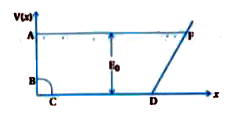 00:37View Solution
00:37View SolutionIn a standing wave formed by two atoms separated by 1.21Å, there are 3 nodes and 2 antinodes. Find its wavelength.
03:24View SolutionA solid spherical ball rolling without slipping collides elastically with an identical ball at rest, as shown in the figure. Assuming that the frictional forces are small enough to have negligible effect during the instant of collision, calculate, the velocity of each ball along enough time after the collision when each ball is again rolling without slipping.
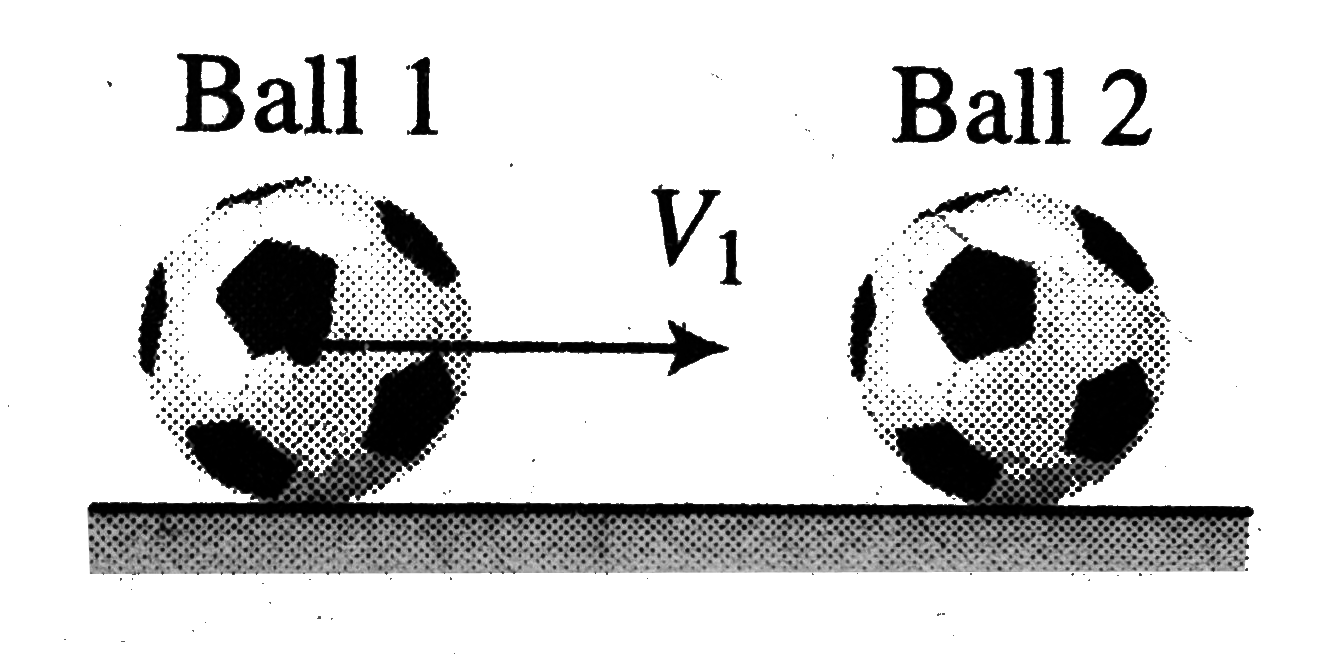 03:59View Solution
03:59View Solution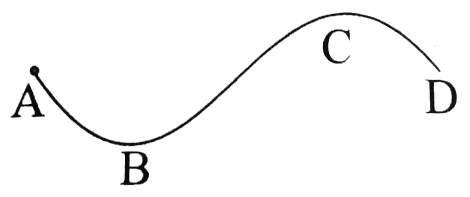
A curved suface is shown in figure. The portion BCD is free of friction. There are three spherical balls of identical radii and masses. Balls are released from rest one by one from A which is at a slightly greater height than C.
Wioth the surface AB, ball 1 has large enough friction to cause rolling down without slipping, ball 2 has a small friction and ball 3 has a negligible friction.
(a) For which ball is total mechanical energy conserved?
(b) Which ball(s) can reach D?
(c )For ball which do not reach D, which of the balls can reach back A?05:22View SolutionIf a body (ball) is rolling on a surface without slipping, no frictional force acts on it
In the case of rolling without slipping point of contacts are relatively at rest.10:00View SolutionA ball moves over a fixed track as shown in the figure. From A and B the ball rolls without slipping. If surface B is frictionless and KA,KB and KC are kinetic energies of the ball at A,B and C respectively then:
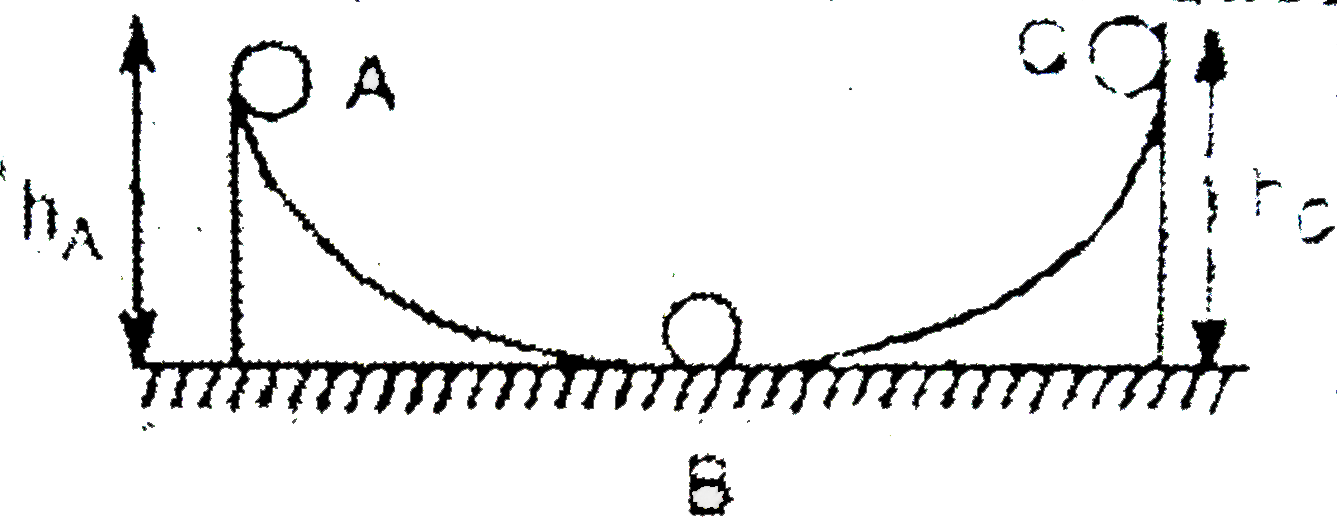 04:01View Solution
04:01View SolutionA solid spherical ball rolls on a horizontal surface at 10 m/s and continues to roll up on an inclined surface as shown in the figure. If the mass of the ball is 11 kg and frictional losses are negligible, the value of h where the ball stop and starts rolling down the inclination is (Assume g= 10 m//s^2 )
06:52View Solutionएक गेंद चित्रानुसार एक स्थिर वक्रीय पथ पर घूमती है। A से B तक गेंद बिना फिसले लुढ़कती है। यदि सतह BC घर्षण रहित है व KA,KB तथा KC गेंद की क्रमशः A,B और C पर गतिज ऊर्जाएं हैं तो
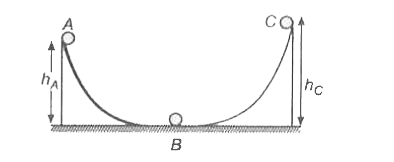 04:52View Solution
04:52View Solutionएक वक्र पृष्ठ को चित्र में दिखाया गया है। भाग BCD घर्षणरहित है। एकसमान त्रिज्या व द्रव्यमानों की तीन गोलीय गेंदे हैं। गेंद A जो कि C की अपेक्षा थोड़ी सी अधिक ऊँचाई पर है। आरंभ करके एक-एक करके विरामावस्था से गेंदों को छोड़ा जाता है, AB सतह के साथ गेंद 1 में बिना फिसले हुए लुढ़कने के लिए पर्याप्त घर्षण है, गेंद 2 में थोड़ा घर्षण है तथा गेंद 3 में नगण्य घर्षण है। किन गेंदों के लिए कुल यांत्रिकीय ऊर्जा संरक्षित होती
 10:00View Solution
10:00View Solution
A curved suface is shown in figure. The portion BCD is free of friction. There are three spherical balls of identical radii and masses. Balls are released from rest one by one from A which is at a slightly greater height than C.
Wioth the surface AB, ball 1 has large enough friction to cause rolling down without slipping, ball 2 has a small friction and ball 3 has a negligible friction.
(a) For which ball is total mechanical energy conserved?
(b) Which ball(s) can reach D?
(c )For ball which do not reach D, which of the balls can reach back A?02:29View Solution
A curved suface is shown in figure. The portion BCD is free of friction. There are three spherical balls of identical radii and masses. Balls are released from rest one by one from A which is at a slightly greater height than C.
Wioth the surface AB, ball 1 has large enough friction to cause rolling down without slipping, ball 2 has a small friction and ball 3 has a negligible friction.
(a) For which ball is total mechanical energy conserved?
(b) Which ball(s) can reach D?
(c )For ball which do not reach D, which of the balls can reach back A?04:59View SolutionA small spherical ball of mass m slides without friction from the top of a hemisphere of radius R.At what height will the ball lose contact with surface of the sphere?
02:02View Solutionचित्र में एक वक्र पृष्ठ दर्शाया गया है। इसका BCD भाग घर्षणरहित है। सर्वसम त्रिज्याओं और द्रव्यमानों की तीन गोलाकार गेंदें दी गई हैं। गेंदों को एक-एक करके बिंदु A से विरामावस्था में छोड़ा जाता है। बिंदु A बिंदु C से कुछ अधिक ऊँचाई पर है।

पृष्ठ AB के साथ गेंद-1 का घर्षण इतना अधिक है कि यह इस पर फिसले बिना लुढ़कती है, गेंद-2 का घर्षण कम है और गेंद-3 का घर्षण नगण्य है
(a) किन गेंदों के लिए कुल यांत्रिक ऊर्जा संरक्षित रहती है?
(b) कौन-सी गेंदें बिंदु D तक पहुँच पाती हैं? (c) जो गेंदें D तक नहीं पहुँच पाती उनमें से कौन-सी गेंदें वापस A पर लौट पाती हैं ?02:25View Solution

